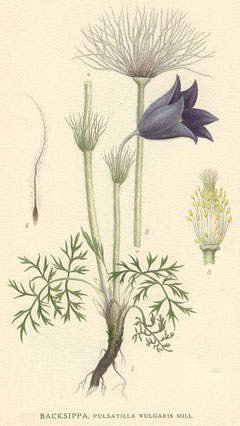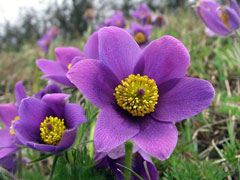 |
|
http://commons.wikimedia.org/wiki/File:Backsippa.jpg |
 |
| http://commons.wikimedia.org/wiki/User:Orchi |
Translate this page:
Summary
Physical Characteristics

 Pulsatilla vulgaris is a PERENNIAL growing to 0.2 m (0ft 8in) by 0.3 m (1ft).
Pulsatilla vulgaris is a PERENNIAL growing to 0.2 m (0ft 8in) by 0.3 m (1ft).
See above for USDA hardiness. It is hardy to UK zone 5 and is not frost tender. It is in flower from April to May, and the seeds ripen from June to July. The species is hermaphrodite (has both male and female organs) and is pollinated by Bees. The plant is self-fertile.
Suitable for: light (sandy) and medium (loamy) soils and prefers well-drained soil. Suitable pH: mildly acid, neutral and basic (mildly alkaline) soils and can grow in very alkaline soils.
It cannot grow in the shade. It prefers dry or moist soil and can tolerate drought.
UK Hardiness Map
US Hardiness Map
Synonyms
Anemone pulsatilla
Plant Habitats
Ground Cover;
Edible Uses
References More on Edible Uses
Medicinal Uses
Plants For A Future can not take any responsibility for any adverse effects from the use of plants. Always seek advice from a professional before using a plant medicinally.
Alterative Antispasmodic Diaphoretic Diuretic Emmenagogue Expectorant Homeopathy Nervine
Ophthalmic Sedative
Pasque flower is considered by herbalists to be of highly valuable modern curative use as a herbal simple[4]. The plant contains the glycoside ranunculin, this is converted to anemonine when the plant is dried and is the medicinally active principle in the plant[268]. The whole plant is alterative, antispasmodic, diaphoretic, diuretic, emmenagogue, expectorant, nervine and sedative[4, 46, 165]. It is taken internally in the treatment of pre-menstrual syndrome, inflammations of the reproductive organs, tension headaches, neuralgia, insomnia, hyperactivity, bacterial skin infections, septicaemia, spasmodic coughs in asthma, whooping cough and bronchitis[238]. Externally, it is used to treat eye conditions such as diseases of the retina, senile cataract and glaucoma[244]. This remedy should be used with caution[165], excessive doses cause diarrhoea and vomiting[238]. It should not be prescribed to patients with colds[238]. See also the notes above on toxicity[165]. The plant is harvested soon after flowering, it is more poisonous when fresh and so should be carefully preserved by drying[4, 268]. It should not be stored for longer than 12 months before being used[4]. In homeopathy, the plant is considered to be specific in the treatment of measles[244]. It is also used for treating nettle rash, toothache, earache and bilious indigestion[244].
References More on Medicinal Uses
The Bookshop: Edible Plant Books
Our Latest books on Perennial Plants For Food Forests and Permaculture Gardens in paperback or digital formats.

Edible Tropical Plants
Food Forest Plants for Hotter Conditions: 250+ Plants For Tropical Food Forests & Permaculture Gardens.
More

Edible Temperate Plants
Plants for Your Food Forest: 500 Plants for Temperate Food Forests & Permaculture Gardens.
More

More Books
PFAF have eight books available in paperback and digital formats. Browse the shop for more information.
Shop Now
Other Uses
Dye
A green dye is obtained from the flowers[238]. Plants can be grown to form a ground cover, they are best spaced about 30cm apart each way[208].
Special Uses
Ground cover
References More on Other Uses
Cultivation details
Requires a well-drained humus rich gritty soil in a sunny position[200]. Lime tolerant[1]. Prefers lime[187]. Grows best in a well-drained chalky soil in a dry warm situation[268]. Established plants are fairly drought tolerant[190]. A very hardy plant, tolerating temperatures down to about -20°c[187]. A very ornamental plant[1], there are many named varieties[187]. The plant has become rare in its natural environment, due partly to over-collecting and partly to habitat loss[238]. Large plants transplant badly[200]. A greedy plant, inhibiting the growth of nearby plants, especially legumes[54].
References Carbon Farming Information and Carbon Sequestration Information
Temperature Converter
Type a value in the Celsius field to convert the value to Fahrenheit:
Fahrenheit:
The PFAF Bookshop
Plants For A Future have a number of books available in paperback and digital form. Book titles include Edible Plants, Edible Perennials, Edible Trees,Edible Shrubs, Woodland Gardening, and Temperate Food Forest Plants. Our new book is Food Forest Plants For Hotter Conditions (Tropical and Sub-Tropical).
Shop Now
Plant Propagation
Seed - best sown as soon as it is ripe in early summer in a cold frame. The seed usually germinates in about 2 - 3 weeks. Sow stored seed in late winter in a cold frame. Germination takes about 1 - 6 months at 15°c. When they are large enough to handle, prick the seedlings out into individual pots and grow them on in the greenhouse for at least their first winter. Plant them out into their permanent positions in the spring. Root cuttings, 4cm long taken in early winter, potted up in a mixture of peat and sand[175]. They can also be taken in July/August, planted vertically in pots in a greenhouse or frame. Some care is needed since the plant resents root disturbance[200].
Other Names
If available other names are mentioned here
Native Range
EUROPE: Denmark, United Kingdom, Sweden (south), Austria, Belgium, Czech Republic, Germany, Hungary, Poland, Ukraine, Romania (north), Serbia, France
Weed Potential
Right plant wrong place. We are currently updating this section.
Please note that a plant may be invasive in one area but may not in your area so it's worth checking.
Conservation Status
IUCN Red List of Threatened Plants Status :

Growth: S = slow M = medium F = fast. Soil: L = light (sandy) M = medium H = heavy (clay). pH: A = acid N = neutral B = basic (alkaline). Shade: F = full shade S = semi-shade N = no shade. Moisture: D = dry M = Moist We = wet Wa = water.
Now available:
Food Forest Plants for Mediterranean Conditions
350+ Perennial Plants For Mediterranean and Drier Food Forests and Permaculture Gardens.
[Paperback and eBook]
This is the third in Plants For A Future's series of plant guides for food forests tailored to
specific climate zones. Following volumes on temperate and tropical ecosystems, this book focuses
on species suited to Mediterranean conditions—regions with hot, dry summers and cool, wet winters,
often facing the added challenge of climate change.
Read More
Expert comment
Author
Mill.
Botanical References
17200
Links / References
For a list of references used on this page please go here
Readers comment